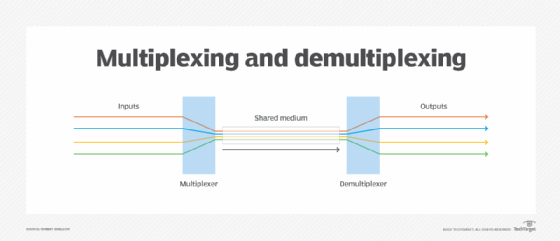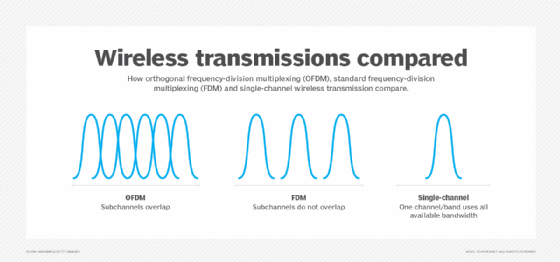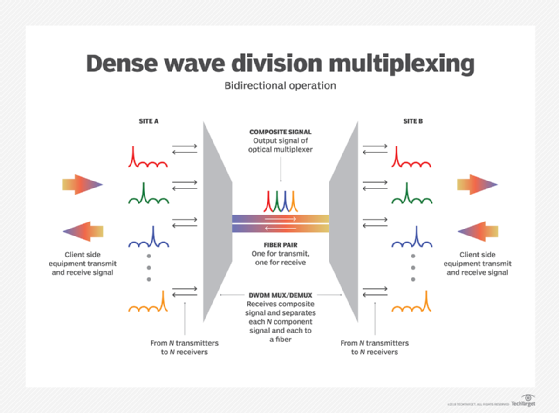multiplexing
What is multiplexing?
Multiplexing, or muxing, is a way of sending multiple signals or streams of information over a communications link at the same time in the form of a single, complex signal. When the signal reaches its destination, a process called demultiplexing, or demuxing, recovers the separate signals and outputs them to individual lines.
Multiplexing is a method used by networks to consolidate multiple signals -- digital or analog -- into a single composite signal that is transported over a common medium, such as a fiber optic cable or radio wave. When the composite signal reaches its destination, it is demultiplexed, and the individual signals are restored and made available for processing.
Networks use a variety of multiplexing techniques, but at a conceptual level, they all operate in a similar manner. The individual network signals are input into a multiplexer (mux) that combines them into a composite signal, which is then transmitted through a shared medium. When the composite signal reaches its destination, a demultiplexer (demux) splits the signal back into the original component signals and outputs them into separate lines for use by other operations.

What is multiplexing used for?
Multiplexing is used in a wide range of industries to facilitate both analog and digital communications. It was first introduced in the 1870s to support telegraphy but has since become a mainstay in telecommunications, such as radio, television and telephone. It is also used in computer networks, often to transmit multiple signals across a wide area network (WAN).
Organizations implement multiplexing on their networks for two reasons:
- to enable network devices to communicate with each other without needing a dedicated connection between each device pair, although multiplexing still requires shared media; and
- to better utilize scarce or expensive network resources. For example, multiplexing can be used to transmit multiple signals across a satellite uplink or on a cable or fiber strand running between major metropolitan areas.
What are the types of multiplexing?
Organizations can select from multiple forms of multiplexing. Their choices will depend in large part on the types of signals being transmitted -- analog vs. digital -- and the media used to carry those transmissions, such as coaxial cable, fiber optic cable or microwave link.
The following is an overview of several common multiplexing techniques.
Frequency-division multiplexing (FDM). Bandwidth on a communications link is divided into subchannels of different frequency widths, each carrying a signal in parallel with the other signals. Analog radio transmissions commonly use FDM to multiplex signals across radio waves. Analog cable TV also uses FDM, sending multiple channels down the same strands of coaxial cable. An offshoot of FDM is orthogonal frequency-division multiplexing (OFDM), which transmits subchannel frequencies closer together, while enabling them to overlap and still remain separate.

Wavelength-division multiplexing (WDM). Multiple communications channels are consolidated and then transmitted on lightwaves with different wavelengths. Conceptually, this is similar to FDM, except that FDM is described in terms of frequencies -- radio or television broadcasting, for example -- whereas WDM is specific to wavelengths. The WDM approach is more common in telecommunication systems and computer networks that use laser systems to send light signals over fiber optic cables. WDM variations include coarse WDM and dense WDM (DWDM), which put fewer or more channels of information, respectively, on the medium at the same time.
Time-division multiplexing (TDM). Multiple digital signals are transmitted over the same channel in alternating time slots. TDM operates at the temporal level, unlike FDM and WDM, which operate at the frequency or wavelength level. Although TDM has its roots in telegraphy, it is now commonly used in digital telephony to transmit multiple conversations across a common medium. TDM is also used on Synchronous Optical Network links, which were once the mainstay of enterprise WAN and internet connectivity. TDM can be either synchronous or asynchronous.

Code-division multiplexing (CDM). A sequence of bits called the spreading code is assigned to each signal to distinguish one signal from another. The spreading code is combined with the original signal to produce a new stream of encoded data, which is then transmitted on a shared medium. A demux that knows the code can then retrieve the original signals by subtracting out the spreading code, a process called dispreading. CDM is widely used in digital television and radio broadcasting and in 3G mobile cellular networks -- 4G and 5G primarily use OFDM. CDM can also support multiple signals from multiple sources, a technique known as code-division multiple access.
Space-division multiplexing (SDM). Signal paths are spatially separated through the use of multiple conductors, such as optical fibers or electrical wires. The conductors are bundled into a single transport medium but are physically separated, with each conductor handling a transmitted channel. Individual conductors can be further multiplexed through the use of FDM, TDM or other techniques. SDM is often used in submarine cable systems to help increase capacity, but it can also be used for wireless communications.
Polarization-division multiplexing (PDM). Incoming electromagnetic signals are polarized into orthogonal channels that are transmitted through a common medium. PDM is frequently used in fiber optics communications, as well as radio and microwave transmissions. For example, satellite TV providers often use PDM to deliver TV signals to satellite dishes.



